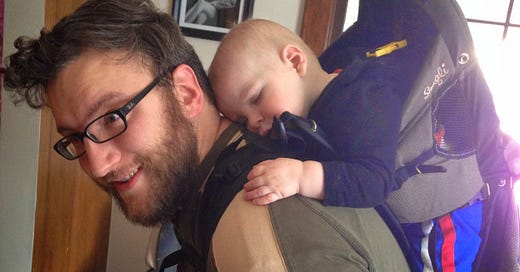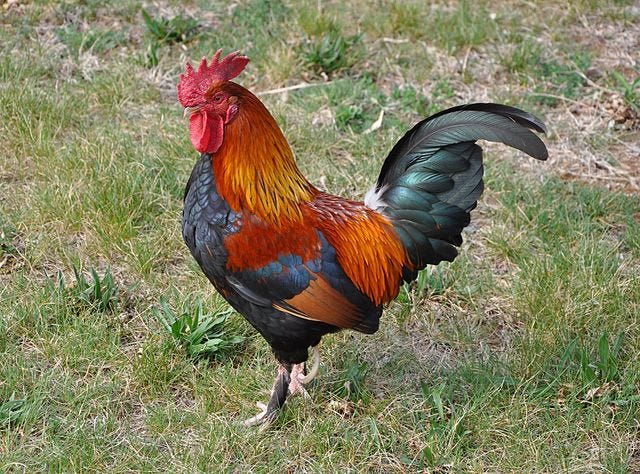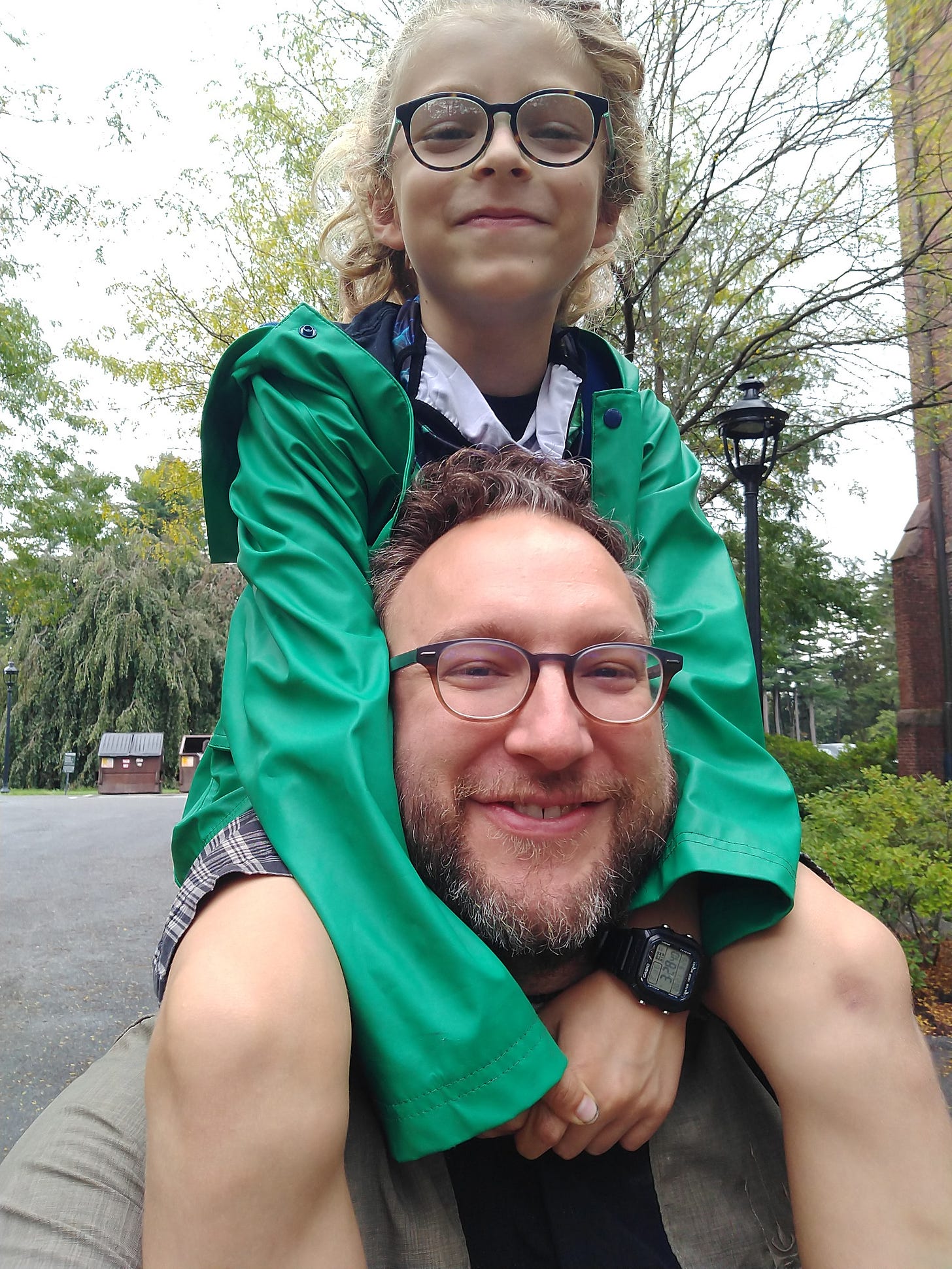For a while, I did not know what to tell people to call me: stay-at-home dad implied that I was an exception, that most dads (real dads) picked up briefcases or thermoses and went to work as god and Henry Ford intended. House-husband wasn’t bad, as I felt like it connected me to a tradition of honorable work, but is literally redundant if you know what husband means. Primary caregiver called to me, though it was too formal and it seemed to neglect the incredible amount of work my son’s mother did. Caregiver worked, though. It was what I wanted to be, not just what I did.
But this was about what people called me: it was their anxiety over my role of taking care of my son, not mine. I was anxious about doing a good job in a task I was unprepared for—society seemed most concerned about what diaper bag I was carrying.
“Dad Bag”, “Man Bag”, “EDC”, “Go Bag” (apparently this was supposed to be very funny), but please don’t call it a diaper bag. That might reveal its true purpose! No, wait, that might recall what it was supposed to be for, but would definitely negate the true purpose of these bags, which was to remind me and anyone looking that while I may have decided to help care for children, rest assured, citizens, I was prepared to be a MAN at any moment. And that only included changing a soiled diaper under part-time, socially sanctioned situations, and should preferably include a kevlar coating. Just in case I was called upon to be a real hero.
Paramilitary branding is bizarrely pervasive among bags for men. My backpack advertises its laptop pocket as “bomb proof.”
But carrying heavy things over distance isn’t something the military owns. It is, in many ways, the essence of being human.
In her essay, “The Carrier Bag Theory of Fiction'', Ursula LeGuin picks up Elizabeth Fisher’s assertion that the first object humans created may not have been a spear or a club but rather a bag:
We’ve heard it, we’ve all heard about all the sticks and spears and swords, the things to bash and poke and hit with, the long, hard things, but we have not heard about the thing to put things in, the container for the thing contained. That is a new story. That is news.
And it shocked me, when my magical partner Jess Waters read me this essay, that it was news. That something this clear and obvious had been outside my vision, blind to because of my attention being put elsewhere. By focusing on the carrier bag, LeGuin insightfully critiques the patriarchal story structure of the hero murdering his way to glory. A woven bag of grass is her metaphor for how we pick things up and generate stories about living, about the lives of people—which as she points out, should (shocking!) include women (this is an oversimplification of her insights: please go check it out).
This essay moved me deeply. It re-ordered the story I was told about the world – the story of how to tell stories. And while LeGuin was powerfully pointing out that this concept re-ordered the gendered divide in stories, it hit me that this was also the way out of many problems with toxic masculinity.1
***
My Dad showed me True Grit when I was 10 or so, and I fell in love with Rooster Cogburn, and John Wayne playing him. It’s hard, actually, to find a better example of toxic masculinity than John Wayne in most of his characters2, though I love him in the roles where he transcends that: Angel and the Bad Man, Who Shot Liberty Valance3, and True Grit. There’s a famous scene that every man I’ve ever talked with about the movie references—brave Rooster faces four outlaws. They taunt each other and then ride, guns blazing, into a duel where the outcome can only be death for one side or the other. Some people think this is the “grit” talked about as the nature of courage in that movie. But it’s not what moves me, and it’s never been what brings me to tears.
In a subsequent scene the young heroine Mattie is bitten by a snake. And Rooster knows she must get to a doctor or die. The John Wayne version includes this moment, too, but it’s the Coen Brothers’ take that brings it home. Rooster rides his horse to death to get her back, and when that fails, he carries her himself, almost coming to the same fate as his horse. “I’m grown old” he says when he can’t quite get her to the house, and must fire his pistol to call for help. But that is the kind of old I want to be. That action of sacrifice, of carrying her, of giving it all for the moment that she could live — in an act that is not a song of legend—that is grit to me. That is and was what it meant to be a man.
This narrative isn’t perfect. It’s still entangled in the heroic. There’s a piece from Always Coming Home that addresses this issue:
The four survivors mummified their companions’ bodies, with the aid of the bone-desert dry climate of the South Coast, and so were able to carry them home for burial—four alive carrying four dead for a month’s journey. The feat was spoken of with sympathy, but not with admiration; it was a bit excessive, a bit too heroic, for Valley approbation.
A bit too heroic. A bit excessive. And maybe in its time, True Grit couldn’t totally shed that frame, but it works very hard to cut into the structure of the story. The climax should be the duel with the bandits. It shouldn’t involve the commonplace story of a girl getting a snake bite, something that could have happened in any story of working a ranch, that seems out of place in a story of justice and revenge. In the John Wayne version, the hero secures a cart rather than continuing to ride on a horse. The story is urging us to re-order what’s happening, and to move the story of Rooster and Mattie from the heroic to the human. It’s a good thing in this moment that Rooster doesn’t die—that glory is far away. This is not the good death. It is the start of a better life.
***
Grit. Fortitude. One of the four cardinal virtues (the others being temperance, prudence, and justice) inherited by the medieval church from classical society. In the Marseilles tarot, it’s represented as a woman holding the mouth of a lion open, taming it. To quote Yoav Ben Dov,
The card expresses self-confidence and personal strength, without the need for violence or forceful oppression.
Fortitude isn’t in the act of struggle, though it may include the capacity to do that. It is strength and toughness used with restraint to create a benefit. It requires daring and patience. This virtue is what I want to practice.
Unsurprisingly, it is characterized as having a female energy in the tarot. One of the teachings in taijiquan connected to its legendary hero Zhang Sanfeng is that in order to practice taijiquan effectively a man must become like a woman. Zhang, that old taoist rascal, isn’t very clear about what he means by that. But I think he means something like what is also embedded in the tarot: that strength is most complete when it is gentle. That men, to grow healthy and use their strength best, have to learn from women. To carry and support, rather than give in to violence.
***
To say that men must learn from women if they are to fully understand the potential of their strength is not to say there is no difference in strengths or experiences, or to negate the beautiful spectrum of power and experience that exist in this life. It is meant, rather, to point out that the way we teach men to exercise strength currently is fragile and dangerous, leading to everyone’s detriment. When even my diaper bag must be advertised as “tactical” and my backpack is designed based on kit used by “Special Forces”, the messaging is clear: my capacity and intent to do violence is the currency of masculinity. To be a hero is be swaddled in death for the benefit of the State. To quote LeGuin again:
So long as culture was explained as originating from and elaborating on the use of long, hard objects for sticking, bashing, and killing, I never thought I had, or wanted, any particular share in it.
If this is really what masculinity means, I want no part in it either.
“What Freud mistook for her lack of civilization was really woman’s lack of loyalty to civilization,” Lillian Smith observed.
Perhaps, with even a cursory view of history, it’s clear that women owe civilization, or empire, or patriarchy—whatever word you want to throw at it—no loyalty. But neither should men.
This is what it means to become like a woman: to listen to our sisters, and to live. To abandon our posts, to drop our duties in favor of kinder, gentler ways. To hear Grandmother Ursula again, we men let ourselves become co-opted by the killer story. It is time, now, to seek the story of the living, to reject that our value is in violence and embrace the frightening and spectacular chance to create a life.
I started thinking of when I had been proud of my strength. My buddy Mike and I laugh that it’s clear we weren’t built to be warriors, but farmers. We have broad backs and solid shoulders meant to bring a hay bale in from the field. We make big targets. When my son fell on his scooter going down too steep a hill and scraped his face, I was proud I could scoop him up and carry him home. When I went on a disastrous hike with Jess and some other friends, I was proud I could carry enough water for us to share. I’ve moved couches into three story walk ups, stopped a piano from crushing a friend, pushed countless cars (not really carrying, but I’m still proud of it), brought back myriad treasures from the woods that my son couldn’t bear to lose, lifted lovers to bed, hiked blocks with the case of wine that made the party. This isn’t power: this is strength. It has always felt like what my body was meant to do.
Rooster, it turns out, is an apt name for the hero of True Grit. Roosters seem like they would make icons for the toxic masculine: vain, loud, jealous, and incredibly violent. Except, that only makes sense if you already buy the lie, and your vision is clouded by the metaphor, rather than actually spending time with roosters.
The rooster’s life is one of service. His bright feathers call a predator’s attention. His call is a warning, rather than a domineering note of command. He searches for the best food he can to offer to the hens. He fertilizes the eggs and watches over the flock. And yes, he may be called upon to fight for the flock, but it is not the majority of his function, which is to make a space for flourishing: in his own fashion, to build something better.
***
My son is 9, now. Where he used to fit cradled in my forearm, now he comes up to my belly. His long legs and arms are perfect for climbing trees, for sprinting across a field. He rarely needs me to carry him at all, though he still likes it.
Visiting with friends on their farm last weekend, he fell asleep next to the campfire, wrapped in a sleeping bag. When it was time to head back up to the house from the low field, I slung all 70 lbs of him and the sleeping bag up into front carry. I don’t think he woke up at all, and so will not have the memory of me carrying him up the hill, huffing and puffing more than I would like to, even if I was not forced to admit I had grown old just yet. He breathed quietly, safe in his own dreams. And as I laid him down without waking him, my back ached and I was truly happy.
Toxic masculinity works as a term for me. It proposes that there is a healthy masculinity, and that we have had the well poisoned by archonic forces who wish to twist something good into their own shape. It speaks to the addiction to violence, a power which I think cannot be overstated in its effect of trapping men.
And in real life, apparently.
Debatable, but, you know, still good.









🐓👜🥖
❤️